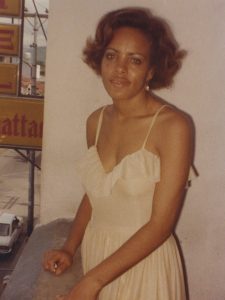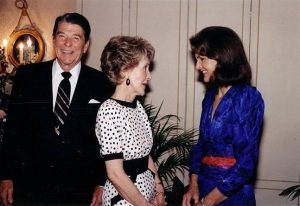Women’s fashion
Early 1980s (1980–1982)
Minimalism

The early 1980s witnessed a backlash against the brightly colored disco fashions of the late 1970s in favor of a minimalist approach to fashion, with less emphasis on accessories. In the US and Europe, practicality was considered just as much as aesthetics. In the UK and America, clothing colors were subdued, quiet and basic; varying shades of brown, tan, cream, and orange were common.
Aerobics craze
The fitness craze of the 1970s continued into the early 1980s. General women’s street-wear worn in the early 1980s included ripped sweatshirts,[19] tights, sweatpants,[20] and tracksuits (especially ones made in velour).
Increased Formality
Continuing a trend begun by designers in 1978,[23][24] the early 1980s also saw a return to pre-sixties ideas of formality,[25][26][27] with coordinated suits,[28] occasion dressing like forties-fifties-revival cocktail dresses and evening dresses, and even a revival of hats and gloves,[29][30] though neither was required for women as they had once been.[31] This was just one trend among many of the era. Along with this went an increased prevalence of black being worn,[32] a trend that can be traced both to high-fashion designers[33] and to late seventies punk fashions and their successors.[34] Black would continue to be prominent in fashion into the early nineties.[35]
Professional fashion
In the 1970s, more women were joining the work force, so, by the early 1980s, working women were no longer considered unusual. As a way to proclaim themselves as equals in the job market, women started to dress more seriously at work. Popular clothes for women in the job market include knee-length skirts, wide-legged slacks, a matching blazer, and a blouse of a different color. Kitten-heeled shoes were often worn.[10] Formal shoes became more comfortable during this period in time, with manufacturers adding soles that were more flexible and supportive.[36] The shoes with moderately spiked heels and relatively pointy toes from the very late 1970s remained a fashion trend.
Mid-1980s (1983–1986)
Bright colors
Women’s fashion in the early 1980s became more colorful around 1982. This included long wool coats, long flared skirts, slim miniskirts, slightly tapered pants and stirrup ones, designer jeans,[11] spandex cycling shorts,[37] high waisted ankle length jeans and pants plain or pleated, extremely long and bulky sweaters, jumpsuits, pastel colors, “off-the-shoulder” sweatshirts over tight jeans, leather trenchcoats, fur coats, extremely large scarves, beanies, leather gloves, and dresses worn with wide or thin belts. The aerobics craze of the early 1980s continued into the mid-1980s, but the clothes became more colorful than they were before.
Power dressing

The television prime time shows Dallas and, in particular, Dynasty influenced increasingly oversized shoulder pads. Shoulder pads, popularized by Joan Collins and Linda Evans from the soap opera Dynasty were popular from the mid-1980s to the early 1990s. Dallas, however, promoted displays of wealth involving jewelry and sparkling clothing.[53] Meanwhile, women’s fashion and business shoes revisited the pointed toes and spiked heels that were popular in the 1950s and early 1960s. Some stores stocked canvas or satin covered fashion shoes in white and dyed them to the customer’s preferred color, preferably bright colors.
Late 1980s (1987–1989)
Consumer-friendly fashions
From 1987 until the early 1990s, the mini skirt was the only length supported by fashion designers. Although skirts of any length were acceptable to wear in the years before, all attention was given to the short skirt, especially among teenage girls and young women worn with tights, pantyhose, leggings, or slouch socks. Shoulder pads became increasingly smaller.[10] Accessories popular in Britain, France and America included bright-colored shoes with thin heels, narrow multicolored belts, berets, lacy gloves, beaded necklaces, and plastic bracelets.[10]
Asian fashion
In Mainland China, the unisex Zhongshan suit[60] declined after the death of Mao Zedong,[61] the removal of the Gang of Four, and the liberalisation of trade links and international relations during the mid and late ’80s. Wealthier Chinese women began wearing Western inspired fashions again,[62] including red or yellow miniskirts[63] in addition to the more typical shirt dresses, white plimsolls and dacron blouses.[64]